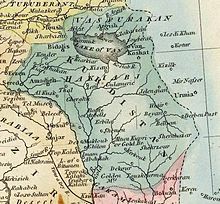| Kurdistan Eyalet | |||||||||
|---|---|---|---|---|---|---|---|---|---|
| 1846–1867 | |||||||||
 | |||||||||
| Capital | Diyarbekir | ||||||||
| History | |||||||||
• Established | 1846 | ||||||||
• Disestablished | 1867 | ||||||||
| |||||||||
| Today part of | |||||||||
Kurdistan Eyalet (Ottoman Turkish: ایالت کردستان, romanized: Eyâlet-ı Kurdistan) was an eyalet of the Ottoman Empire. It was the first time that the Ottoman Empire used the term "Kurdistan" to refer to an administrative unit rather than a geographical region. It was formed with the aim of establishing direct control over Kurdistan, rather than recognizing it as a political entity.[1]
History[edit]
It was a short-lived province as it only lasted about 21 years, between 1846 and 1867.[2] One year after its establishment the Kurdish strongman Bedir Khan Beg and former ruler of large parts of the Kurdistan Eyalet, was defeated in his castle in Eruh.[3] Following the region lacked of a powerful Kurdish ruler which led to the rise of the religious sheikhs belonging to the Naqshbandi and Qadiriyya dervish orders, or tariqas. In 1867 it was abolished and succeeded by the Diyarbekir Vilayet.[4] During its existence, it saw twelve different governors who had either the title of müsir or vizier.[5]
Extension[edit]
Initially the eyalet covered the region of the former Kurdish Emirate of Bohtan, but it was expanded gradually[6] and at its widest extension included the former Diyarbekir Eyalet and the areas around Van, Hakkari and Muş, as well as the districts of Botan, Mardin, and Cizre. According to the salnames between 1847 and 1867, it was ruled by the central Ottoman government and received annual funding of 80,000 piastres,[7] considerably more than the Mosul Eyalet.[8] In 1853 the eyalet counted with four sancaks, namely the ones of Diyarbakir, Muş, Siirt and Dersim.[3] The tax register of 1852 also named the cities Cizre, Muş and Hakkari among others.[3]
Legacy[edit]
Recep Tayyip Erdoğan proposed a revival of the Kurdistan Eyalet in 2013, claiming that Southeastern Anatolia was always referred to as Kurdistan before the 1923 establishment of the Republic of Turkey.[9] His remarks referring to the provincial administration of the Ottoman Empire was criticised by many who interpreted them as signs of Erdoğan’s desire to implement a federal system. To challenge the Turkish nationalists, Erdogan recalled that during the Ottoman era there were eyalets called Kurdistan and Lazistan.[10] He stated that autonomous self-governance within the state of Turkey should be possible and would even be a source of strength for Turkey.[11]
References[edit]
- ^ Yadirgi, Veli (3 August 2017). The Political Economy of the Kurds of Turkey. ISBN 9781107181236.
- ^ Özoğlu, Hakan (2004). Kurdish Notables and the Ottoman State: Evolving Identities, Competing Loyalties, and Shifting Boundaries. SUNY Press. pp. 60–63. ISBN 978-0-7914-5993-5.
- ^ a b c Badem, Candan (2010), "The impact of the war on ottoman social and political life", The Ottoman Crimean War (1853-1856), Brill, p. 364, JSTOR 10.1163/j.ctt1w8h1kf.12
- ^ Aydın, Suavi; Verheij, Jelle (2012). Jorngerden, Joost; Verheij, Jelle (eds.). Social Relations in Ottoman Diyarbekir, 1870-1915. Brill. p. 18. ISBN 9789004225183.
- ^ Ozoglu, Hakan (2004-02-12). Kurdish Notables and the Ottoman State: Evolving Identities, Competing Loyalties, and Shifting Boundaries. SUNY Press. pp. 62–63. ISBN 978-0-7914-5993-5.
- ^ Özoğlu, Hakan (2004), pp.61–62
- ^ Özök-Gündogan, Nilay (2012). Jorngerden, Joost; Verheij, Jelle (eds.). Social Relations in Ottoman Diyarbekir, 1870-1915. Brill. p. 186. ISBN 9789004225183.
- ^ Özoğlu, Hakan (2004), p.61
- ^ hurriyetdailynews.com - Politicians hit below belt in Kurdish debate
- ^ al-monitor.com - Turkey's Nationalists Threaten Inter-Communal Fighting
- ^ dailysabah.com - PM Erdoğan: Those who withdraw will have to drop their weapons